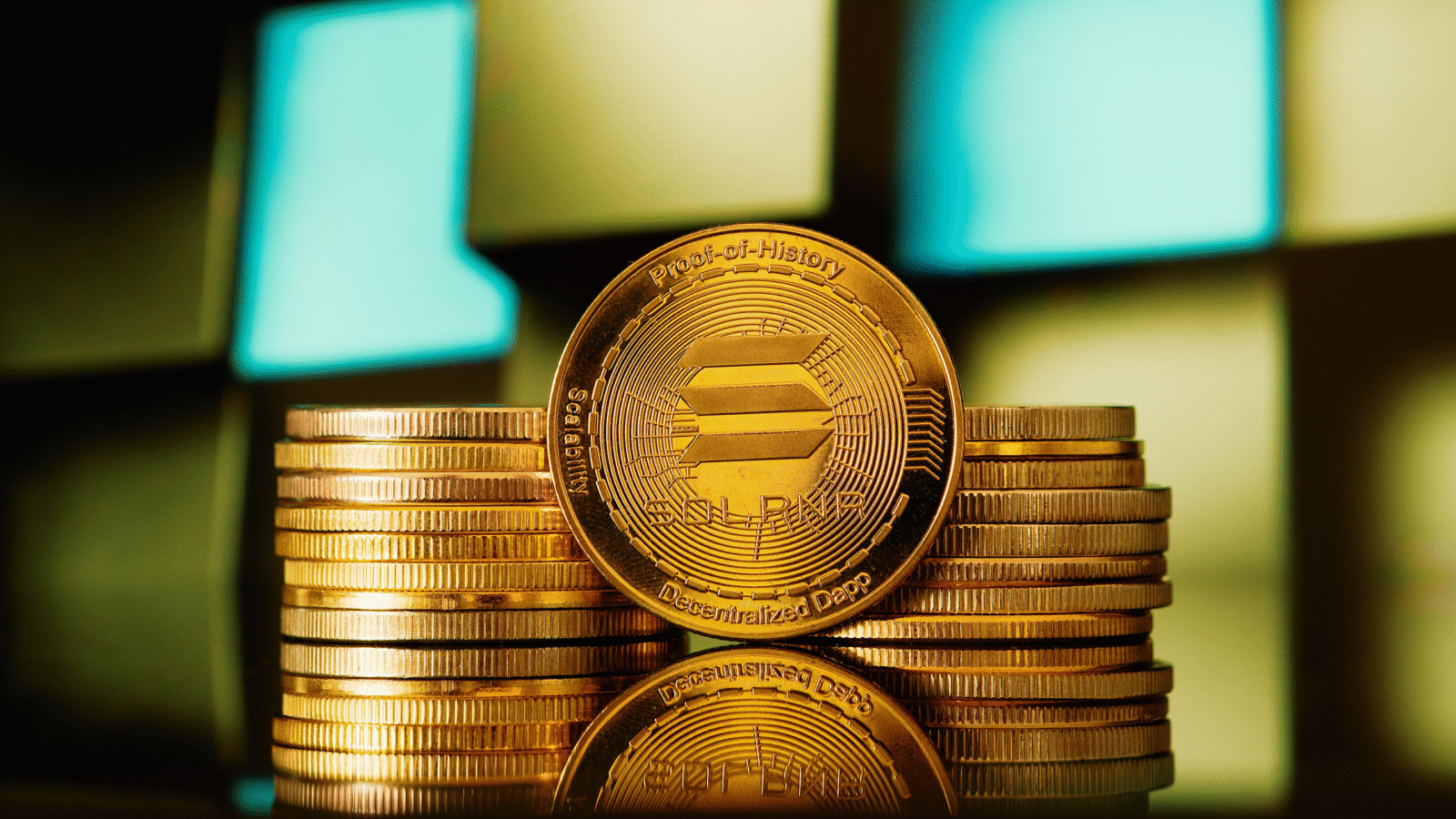Good morning!
HODL the phone.
While cryptocurrencies are still finding their way into clients’ portfolios, the enthusiasm for Bitcoin, and a laundry list of products that track it, has been otherworldly as of late. BlackRock’s iShares Bitcoin ETF (IBIT) is driving more revenue than its iShares Core S&P 500 ETF (IVV), one of the most popular funds on the planet. The Bitcoin fund generates $191 million in revenue per year, outpacing the S&P fund, Bloomberg reported. IBIT holds just over $76 billion in assets compared with IVV’s $628 billion, but IBIT’s expense ratio is more than eight times that of IVV’s.
Seems like only yesterday that Bitcoin was a fringe trend dominated by Silicon Valley geeks and online casinos. Oh, the good old days.
All Sunshine for First Spot Solana ETF

The first spot-price Solana ETF has landed, and it’s in a lonely position.
The Rex-Osprey SOL + Staking ETF (SSK) started trading last Wednesday on Cboe after being approved by the Securities and Exchange Commission the previous week. While numerous ETF issuers have been queuing up for spot Solana approval, most have filed their products under the Securities Act of 1933, rather than the 1940 Act, as the Rex-Osprey fund did. Spot-price crypto exchange traded products, such as those for bitcoin and ether, have had success in getting the SEC’s approval under the 1933 Act, given the regulator’s stance that the crypto assets may not be securities. However, the path for products that offer proof-of-stake rewards, in which crypto owners are compensated for “staking” some of their tokens to validate transactions on the network, has not been as easy. Filing under the 1940 Act, which covers securities, worked in Rex-Osprey’s favor.
“We took a different path,” the companies’ founder and CEO Greg King said. “The innovation here is we were able to use a 40 Act structure to bring Solana exposure to the market.”
What’s At Stake
Demand for anything other than spot bitcoin and, to a lesser extent ether, in ETF or ETP form hasn’t been strong. The question is whether staking could meaningfully change that. “It’s like having your money in a checking account that pays zero versus putting it in a money market,” King said. Total expenses for the ETF are 128 basis points, 75 of which are the management fee.
Observers had tempered optimism about the fund’s potential:
- “I’m a fan. All the staking yield is passed to investors with payouts, and Solana in and of itself has great upside potential,” financial consultant Tyrone Ross Jr. said. “The only thing I would quibble with is the fee.”
- “It’s gaining significant interest despite not being a traditional 33 Act spot ETF,” said Roxanna Islam, head of sector and industry research at TMX VettaFi. “But assuming the 33 Act spot Solana funds are launched with fees in line with current spot bitcoin and ether ETFs, that could make this a close race, even with SSK having a significant head start.”
Time in the Sun: The current SEC leadership’s change in treatment of crypto, compared with the prior administration’s, has been encouraging, King said. And, at least on the first day of trading, there was strong interest in the ETF, with more than 800,000 shares traded before noon, he noted. “We’re having a great kickoff day.”
Dimensional Hits $200B in ETF Assets
It took nearly as long to build the Hagia Sophia.
Dimensional Fund Advisors just surpassed $200 billion in ETF assets, a milestone that came less than five years after the firm brought its first exchange-traded fund to the market. Much of the growth has happened since 2023, when it reached $100 billion in ETF assets and began rolling out additional products. That has coincided with two factors putting wind into the ETF business’ sails — demands for low costs and active management. The firm, which takes an untraditional approach to active management, is known for “strategic beta” or “smart beta,” in which investment decisions are passive, but the timing of rebalancing involves active choices. It bills itself as the top issuer of active ETFs.
“Our clients have lots of disparate needs when it comes to investment solutions,” said Wes Crill, senior client solutions director at Dimensional. “The active ETF landscape seems to be growing substantially.”
Activating Funds
Dimensional has seen $123 billion in flows since late 2020, with $44 billion coming into the newly established ETFs via conversions of the company’s existing mutual funds. To date, the firm has 41 ETFs and is effectively first in line for the long-coveted dual share class structure, pending approval by the Securities and Exchange Commission. That development would let asset managers offer ETF share classes of mutual funds and vice versa. Companies that have the capabilities to handle both mutual funds and ETFs could launch versions of existing strategies more easily, and gain tax benefits stemming from ETFs’ in-kind redemptions.
The firm’s ETF sales have been trending up over the past few years:
- The funds have raked in $20 billion so far this year, compared with $38 billion in all of 2024, $31 billion in 2023, and $26 billion in 2022.
- Of the 41 total ETFs, 16 saw net inflows of more than $1 billion last year.
A New Dimension: After investors began shedding shares of Dimensional funds in 2019, the firm lowered fees and introduced its ETFs, which quickly brought sales back up, according to Morningstar. While the company has converted some mutual funds to ETFs, it offers nearly identical strategies in both vehicles, along with separately managed accounts. That’s a necessity, as preferences based on tax treatment can change, Crill said. “What’s interesting today to investors … may not always be the case,” he said. “That’s why we have to have a diverse set of offerings.”
Innovator Launches 2 Dual Directional ETFs

Two new ETFs are designed to let investors benefit from up and down markets — but will they want to?
Innovator ETF’s two new dual directional strategies allow investors to benefit from market upturns or downturns so long as their index, the S&P 500, stays within a certain range. Like most buffered products, the funds limit upside yield and buy additional put options under the hood. The products are mainly aimed at highly risk-averse investors, like retirees or pre-retirees, who are more concerned with capital preservation than capital accumulation, according to Innovator’s director of product strategy Andrew Nelson.
Not all experts are convinced of the product’s utility, however, because of its high upside cap. “The payoff structure works really well when you’re in those negative 10% to negative 15% ranges, and that just doesn’t happen very often,” said Charles Champagne, head of ETF strategy at AllianzIM. “So the payoff structure benefit is a little narrow.”
Upside Down(side)
Dual directional strategies have long existed in the insurance and annuities spaces — for example, with registered indexed-linked annuities, or RILAs — but Innovator’s products mark their entry into the world of ETFs, according to experts. “There’s no free lunch. It’s not magic, it’s not voodoo,” Nelson said. “The cost of this is actually that your ‘normal’ cap, your standard cap that you know and love, is going to be lower than [that of] a competitor.”
The two strategies have slightly different buffer levels and upside caps:
- The Innovator Equity Dual Directional 10 Buffer ETF (DDTL) has a 10% inverse cap and buffer level and a 12.59% upside cap.
- The Innovator Equity Dual Directional 15 Buffer ETF (DDFL) has a 15% inverse cap and buffer level and a 12.59% upside cap.
Product Palooza. The dual directionality funds are the latest introduction of strategies into the ETF world, like autocallables, that have long existed in other spaces. “As issuers try to find new areas to bring products, they look to insurance products and at the structured notes that are available,” Champagne said. “It’s not surprising that these came to market.”
Extra Upside
- Very Shiny. Despite modest inflows, platinum ETFs have outperformed gold and silver ETFs this year.
- On Autopilot. SEC considers automating a significant portion of crypto ETF approval process, sources say.
- H2 Oh. ETFs that track ultra-short and long-term Treasurys, European equities and consumer staples are best positioned for the second half of 2025.
ETF Upside is written by Emile Hallez. You can find him on LinkedIn.
ETF Upside is a publication of The Daily Upside. For any questions or comments, feel free to contact us at etf@thedailyupside.com.
